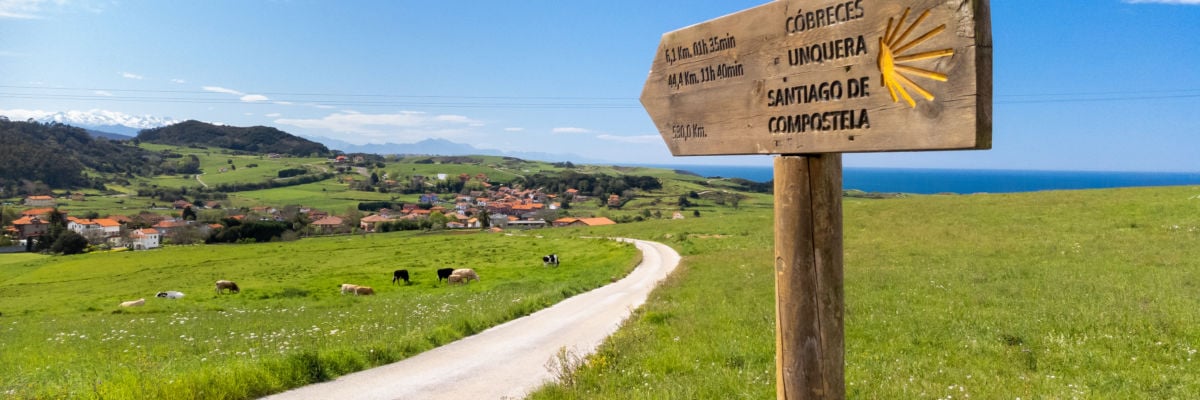
Catholics have much to gain by stepping out and taking an adventure. Pilgrimage is a long-cherished practice in our tradition, and trips to Walsingham, Lourdes, Fatima, and countless other places continue to deepen people’s faith and transform their lives.
The grandaddy of them all is the Camino de Santiago—walking under the Milky Way (“Compostela”) along one of the many different and centuries-old routes through western Europe to the Cathedral of Santiago in northwestern Spain. To this day, young and old, rich and poor, individuals and groups leave their comfort zones to go out into the Way, discovering in the process a rich treasury of grace within their own hearts.
For those of us who have not yet had the opportunity to walk the pilgrim path, director Erin Berghouse and Bishop Donald Hying of the Diocese of Madison, Wisconsin have offered us a gift in the form of the new documentary Santiago: The Camino Within, which will release in select theaters in the United States for one night only tomorrow, March 28. It is well worth seeing, and it provides a good opportunity to invite a friend who may be on his own journey toward the Church.
Throughout the film, Bishop Hying offers voiceover reflections on top of beautiful scenery from the Camino, setting the tone and drawing the audience back at various moments to the importance of the interior journey that accompanies the miles each pilgrim walks during the day. At one point, the bishop reflects: “Maybe I can’t see the whole picture. But enough will be given to me to take another step forward. Faith becomes the way of seeing the way forward.” I thought here of St. John Henry Newman in 1833, ill and alone on a journey to Sicily, in a state of spiritual turmoil he understood only years later. Here he wrote his famous hymn “Lead, Kindly Light,” which includes the verses, “Keep thou my feet; I do not ask to see / The distant scene—one step enough for me.”
Throughout the film, we follow in the footsteps of pilgrims from all over the world. Their testimonies range from light-hearted to agonizing, representing the many different types of people and motivations involved in deciding to walk the Camino. Some of the most effective and affecting scenes in the film involve pilgrims’ conversations with Bishop Hying, who displays a tender pastor’s heart throughout. One man named Francisco, for example, describes how in his normal working life, he spends countless hours at his desk, never seeing the sun. He discusses his motivation to undertake the Camino by saying, “I want to feel the day.” Another pilgrim says that the journey to Santiago is about being “in the moment” and not thinking about “the stresses of tomorrow.”
At one point, Bishop Hying meets two young women, one of whom has recently received the sacrament of confirmation, and the three converse in Spanish together as they walk. Later in the film, an Italian man describes his motivation for walking, which has brought him firmly back to the Faith after the loss of his wife. Two Czech men describe their experience of the Camino on bicycles.
For me, the most moving sequence in the film centered on the journey of a couple from South Korea. Picking up the same theme as the earlier pilgrims who described the need to step away from their day-to-day professional routine, the man explains that he was “exhausted” after a twenty-year stint with the same firm. “All I needed was just, like, escaping from my daily routines,” he confesses, and after weeks away from home, he feels a renewed appreciation for the life to which he will soon return, including his job. His wife declares, “It’s a grace,” and the pair describe how they have providentially run into Bishop Hying several times. The scene then cuts to a tearful moment when they kneel before the bishop, who gives them a heartfelt blessing.
Somewhat discordantly, at the end of the film, we hear an extended bit of a homily on the Transfiguration delivered by an American priest we have not met so far in the film. I very much enjoyed Bishop Hying’s reflections on the person of St. James and his missionary journey, but I would have enjoyed a little more of a travelogue feel, with additional geographical and historical details. Nonetheless, Santiago does something we ought to see more of—namely, simply point a camera at something beautiful and talk about the power and presence of God. The production is not overly elaborate, and refreshingly so, reminding all of us with dreams of using modern media to share the gospel that we can do a lot with a little. It does not take a huge budget to shoot a medieval cathedral, but the payoff is great.
Santiago succeeds admirably with conveying its message: go out there into special places in God’s world in order to grow in relationship with God within. Now that our isolated existences from the pandemic years appear to be receding in our rearview mirrors, perhaps it is time to step out in faith and take a big trip. As Santiago ably demonstrates, the Way of the Lord awaits us all.



